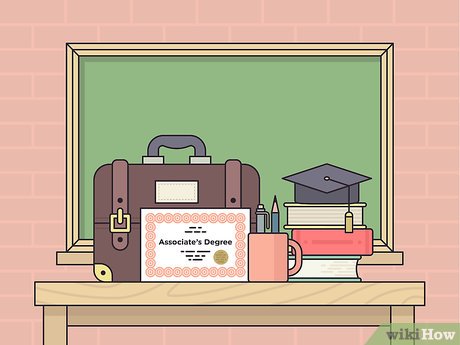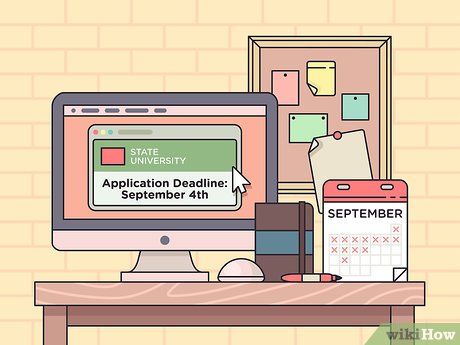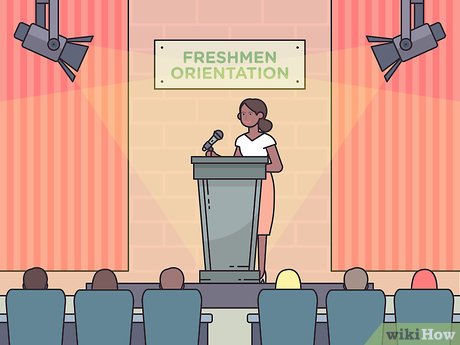How to Transfer from a Community College to a University
Part 1 of 4:
Planning Ahead for Your Transfer
-
 Meet with your academic adviser early on. As soon as you know you plan to transfer to a four-year college or university, even in your first semester, establish with your adviser that this is your goal. They will be able to help you consider factors like prospective class schedules, cost, application deadlines, and transfer credit requirements.[1]
Meet with your academic adviser early on. As soon as you know you plan to transfer to a four-year college or university, even in your first semester, establish with your adviser that this is your goal. They will be able to help you consider factors like prospective class schedules, cost, application deadlines, and transfer credit requirements.[1]- Checking in with your adviser frequently to make sure you are on track to transfer will allow you to avoid having to take extra semesters of classes to meet requirements.
-
 Explore your options for four-year colleges and universities. Whether you have your heart set on a particular school or you have no idea where to go, speak with an academic adviser to get a better understanding of what is realistic. Take your field into consideration, as some schools are better than others in specific fields.[2]
Explore your options for four-year colleges and universities. Whether you have your heart set on a particular school or you have no idea where to go, speak with an academic adviser to get a better understanding of what is realistic. Take your field into consideration, as some schools are better than others in specific fields.[2]- You should check to see if any universities in your state have an articulation agreement with your community college. An articulation agreement streamlines the transfer process by provided a pre-negotiated outline of transfer requirements.[3]
-
 Choose your major early, even if you end up changing it. Knowing the field you plan to enter will help ensure that the classes you take at your community college will count. Having a sense of your major will make it easier to avoid taking general education requirements that may only apply to an Associate's Degree.[4]
Choose your major early, even if you end up changing it. Knowing the field you plan to enter will help ensure that the classes you take at your community college will count. Having a sense of your major will make it easier to avoid taking general education requirements that may only apply to an Associate's Degree.[4]- Your first semester is a good time to figure out your interests and the direction you would like to go, but don't forget that you can change direction if necessary. So long as you are earning credits toward a major, you are in a good position to transfer.
-
 Pick classes based on transferability. While general education classes may be interesting and appealing, confirm before each registration period that the classes you plan to sign up for will transfer to a college of your choice. Your adviser can help with this, and the website of the university you plan to transfer to may list this information.[5]
Pick classes based on transferability. While general education classes may be interesting and appealing, confirm before each registration period that the classes you plan to sign up for will transfer to a college of your choice. Your adviser can help with this, and the website of the university you plan to transfer to may list this information.[5]- Some community colleges use placement exams that frequently place students in classes below their level. Studying for English and math placement exams can help you get into credit-worthy classes from your first semester.[6]
-
 Earn your Associate's Degree, if your community college offers one. There are statistics to show that community college students who graduate with an Associate's Degree are significantly more likely to be admitted to four-year colleges and ultimately complete their Bachelor's Degree.[7]
Earn your Associate's Degree, if your community college offers one. There are statistics to show that community college students who graduate with an Associate's Degree are significantly more likely to be admitted to four-year colleges and ultimately complete their Bachelor's Degree.[7]- Despite this, it is possible to transfer and succeed with only the credits and no degree.
- Most two-year colleges that do not offer an Associate's Degree still have established ways for you to transfer after your fourth semester into junior standing (3rd year).
Part 2 of 4:
Applying for the Transfer
-
 Find out the school's application deadlines. You can easily track down the info on this by going to the college's website, but if you want confirmation you can call the school's admission office. You should find this information as soon as you know you want to apply.[8]
Find out the school's application deadlines. You can easily track down the info on this by going to the college's website, but if you want confirmation you can call the school's admission office. You should find this information as soon as you know you want to apply.[8]- Double check that you are looking at the deadlines for transfer applications, as they sometimes differ from the standard application dates.
-
 Apply to your program in addition to the school, if necessary. Many large state schools require that applicants apply for a specific program, not just the college itself. If you are in a STEM or medical field, this is especially likely. Check your desired school's requirements before applying.[9]
Apply to your program in addition to the school, if necessary. Many large state schools require that applicants apply for a specific program, not just the college itself. If you are in a STEM or medical field, this is especially likely. Check your desired school's requirements before applying.[9] -
 Take the application seriously. Read over the directions and questions multiple times to get an idea of what is expected of you. You should fill out every field, and answer even seemingly minor questions about yourself thoughtfully and thoroughly in order to show your commitment and serious interest.[10]
Take the application seriously. Read over the directions and questions multiple times to get an idea of what is expected of you. You should fill out every field, and answer even seemingly minor questions about yourself thoughtfully and thoroughly in order to show your commitment and serious interest.[10]- You can call the college's admission office with any questions about the application.
-
 Get all of the required recommendations. Having too few (or too many) recommendations is a red flag for many schools. You should ask professors who you have met with and spoken to outside of class, if possible, as they will be able to attest to your character in addition to your abilities.
Get all of the required recommendations. Having too few (or too many) recommendations is a red flag for many schools. You should ask professors who you have met with and spoken to outside of class, if possible, as they will be able to attest to your character in addition to your abilities.- Ask for recommendations early, and spend time cultivating relationships with professors throughout your time at your community college.
-
 Write your essays as if they were being graded. Don't let yourself take shortcuts on the admission essays. Even if you tend to procrastinate, take your time and write something you feel proud of. As you write and re-read, ask yourself if it is something you would be happy to submit to a professor.[11]
Write your essays as if they were being graded. Don't let yourself take shortcuts on the admission essays. Even if you tend to procrastinate, take your time and write something you feel proud of. As you write and re-read, ask yourself if it is something you would be happy to submit to a professor.[11]- Ask a tutor, adviser, teaching assistant, or even a professor you know well to proofread your essay to make sure that it is written at the standard that the college of your choice expects.
-
 Submit your application early or on time. Whether the application is submitted in paper form or online, you should always get your application in as soon as you have finished and reviewed it. Submitting early can save you stress, and it is a necessity if you are mailing the application, as mailing times can vary quite a bit.[12]
Submit your application early or on time. Whether the application is submitted in paper form or online, you should always get your application in as soon as you have finished and reviewed it. Submitting early can save you stress, and it is a necessity if you are mailing the application, as mailing times can vary quite a bit.[12]- If the school you are applying to has a rolling acceptance system, meaning they accept students in the order that they apply, you should apply as close to the opening date of the admission period as possible.
-
 Seek out financial assistance. You should apply early for any financial aid you may need. Before enrolling at a university, file the Free Application for Federal Student Aid (FAFSA) to make sure that you will be able to afford it. You should also find out what kind of transfer scholarships are available at your prospective school.[13]
Seek out financial assistance. You should apply early for any financial aid you may need. Before enrolling at a university, file the Free Application for Federal Student Aid (FAFSA) to make sure that you will be able to afford it. You should also find out what kind of transfer scholarships are available at your prospective school.[13]- Calling or visiting the school's financial aid office will make the process less confusing for you, and more personal for the aid officers.
Part 3 of 4:
Transferring Your Credits
-
 Work with your new school to make sure all of your credits transferred. Most credit transfer will happen automatically, but you should also follow up with emails or calls to the registrar to check on the process. Making sure that your new school gives you credit for your prior college classes is crucial. [14]
Work with your new school to make sure all of your credits transferred. Most credit transfer will happen automatically, but you should also follow up with emails or calls to the registrar to check on the process. Making sure that your new school gives you credit for your prior college classes is crucial. [14]- Be prepared to share syllabi and sample assignments from your classes if the university questions the rigor of the classes. Sometimes classes that you feel were rigorous will be dismissed as below the level of the university.
- Meeting with the registrar can be helpful for clarifying the process, and providing them with more information about the classes you took.
-
 Check on your academic standing. Even if you have met all credit requirements, you should double check that the university has you recorded at the correct level. If you are recorded as a lower class year, ask why, and whether it affects your ability to graduate within the time-frame you had planned on.[15]
Check on your academic standing. Even if you have met all credit requirements, you should double check that the university has you recorded at the correct level. If you are recorded as a lower class year, ask why, and whether it affects your ability to graduate within the time-frame you had planned on.[15] -
 Register for your first semester at a university. Now that you have made it to the university of your choice, you can build on the skills and knowledge you learned in your first two years. Register for classes in your major, taking electives as you are able.
Register for your first semester at a university. Now that you have made it to the university of your choice, you can build on the skills and knowledge you learned in your first two years. Register for classes in your major, taking electives as you are able.- If a class has a prerequisite that you haven't officially met, and you feel you have completed an equivalent, bring that up with your academic adviser as soon as possible. They may be able to work with your former school and the registrar to get you into the higher level class.
Part 4 of 4:
Succeeding at Your New School
-
 Be prepared for a change. Community colleges are often no less rigorous than university classes, but the class sizes and grading scales can differ greatly. Read about succeeding in university classrooms and brush up on relevant class notes before showing up to your first classes.
Be prepared for a change. Community colleges are often no less rigorous than university classes, but the class sizes and grading scales can differ greatly. Read about succeeding in university classrooms and brush up on relevant class notes before showing up to your first classes.- Knowing what to expect will make the transition easier and less stressful.
- You can read about professors and get to know the school's overall reputation online and by speaking with current students.
-
 Attend your new school's freshman orientation programs. Many schools offer special programming for transfer students and students returning from a leave of absence in order to provide them with specific insights about transitioning to the college.[16]
Attend your new school's freshman orientation programs. Many schools offer special programming for transfer students and students returning from a leave of absence in order to provide them with specific insights about transitioning to the college.[16]- This is also a good way to meet your peers in a structured environment and to get over the embarrassment of being new at your school.
-
 Meet with academic advisers at your new college with any questions. Whether you are struggling to get used to the new environment or have questions about succeeding as a transfer student, academic advisers will be able to give you support.[17]
Meet with academic advisers at your new college with any questions. Whether you are struggling to get used to the new environment or have questions about succeeding as a transfer student, academic advisers will be able to give you support.[17]- Check whether your new school has an office devoted to helping transfer students. Often, international students and non-traditional students are grouped together with transfers in the same student services office.
-
 Take classes again if the registrar refuses to grant you credit. While having to retake a class is always an off-putting concept, consider it an easy way to refresh yourself on the topic. You will already have most of the basic knowledge you need, so you can focus on getting the hard concepts nailed down.[18]
Take classes again if the registrar refuses to grant you credit. While having to retake a class is always an off-putting concept, consider it an easy way to refresh yourself on the topic. You will already have most of the basic knowledge you need, so you can focus on getting the hard concepts nailed down.[18]- Taking classes again is often a frustrating experience, but try not to let it hold you back from achieving your goal.
4 ★ | 2 Vote
You should read it
May be interested
- What major silocon valley tycoons study in the university?
 let's see what technology tycoons have chosen which majors to study when studying at university.
let's see what technology tycoons have chosen which majors to study when studying at university. - How to Become a University Lecturer
 university lecturers teach college students in a variety of academic and vocational subjects and using an assortment of different methods, including lectures, seminars, and fieldwork. as such, they have a unique opportunity to shape young...
university lecturers teach college students in a variety of academic and vocational subjects and using an assortment of different methods, including lectures, seminars, and fieldwork. as such, they have a unique opportunity to shape young... - How to Finish College Fast
 whether you're trying to save money or are just eager to move on to the next step in your professional or academic career, finishing college fast may be an attractive option for you. minimize your time in college by signing up for a fast...
whether you're trying to save money or are just eager to move on to the next step in your professional or academic career, finishing college fast may be an attractive option for you. minimize your time in college by signing up for a fast... - Top 10 'most worthless' qualifications in universities (and the reason behind them)
 let's see the top 10 most valuable qualifications in university and the reason behind them!
let's see the top 10 most valuable qualifications in university and the reason behind them! - How to Defend Your Decision Not to Go to College
 as the end of high school approaches, everyone's going to be talking about where they're going to college and their plans for the fall. how do you defend your decision not to go to college like everyone else? having rational explanations...
as the end of high school approaches, everyone's going to be talking about where they're going to college and their plans for the fall. how do you defend your decision not to go to college like everyone else? having rational explanations... - How to Transfer Colleges
 transferring colleges can be a daunting task, but by speaking to the right people, you can make the process that much easier for yourself. as soon as you realize that your current college isn't for you, start checking out other colleges....
transferring colleges can be a daunting task, but by speaking to the right people, you can make the process that much easier for yourself. as soon as you realize that your current college isn't for you, start checking out other colleges.... - How to Succeed in College
 college is a time unlike any other in your life. you have gained independence, you are in a new place, and your adult life is gradually staring you in the face. you have choices to make, and you know it. there is no secret recipe for...
college is a time unlike any other in your life. you have gained independence, you are in a new place, and your adult life is gradually staring you in the face. you have choices to make, and you know it. there is no secret recipe for... - How to Transition from High School to College
 after finishing high school, going to college can be an exciting change from what you're used to. college is a great place to meet new friends, experience new subjects you're interested in, and have more independence. although it may seem...
after finishing high school, going to college can be an exciting change from what you're used to. college is a great place to meet new friends, experience new subjects you're interested in, and have more independence. although it may seem... - Google, Apple and many other large companies employing employees no longer require a college degree
 according to a report by glassdoor, a job search site, there are now 15 leading companies in the world, including apple, google, ibm ... that have changed their recruitment policies and no longer require applications. students must have a university degree.
according to a report by glassdoor, a job search site, there are now 15 leading companies in the world, including apple, google, ibm ... that have changed their recruitment policies and no longer require applications. students must have a university degree. - How to Pick a College Major
 choosing a college major is an important decision. your major can significantly shape your future. some people prefer to follow their passions by selecting a major that makes them happy and enthusiastic. others examine more practical...
choosing a college major is an important decision. your major can significantly shape your future. some people prefer to follow their passions by selecting a major that makes them happy and enthusiastic. others examine more practical...





























 How to Succeed in College with Young Children
How to Succeed in College with Young Children How to Apply to University of Toronto
How to Apply to University of Toronto How to Return to School in Your Fifties
How to Return to School in Your Fifties How to Crash a Class in College
How to Crash a Class in College How to Choose University Courses
How to Choose University Courses